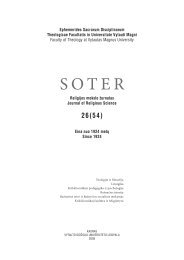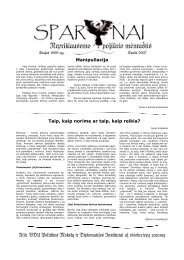Untitled - Vytauto Didžiojo universitetas
Untitled - Vytauto Didžiojo universitetas
Untitled - Vytauto Didžiojo universitetas
You also want an ePaper? Increase the reach of your titles
YUMPU automatically turns print PDFs into web optimized ePapers that Google loves.
to the specificity of the Grand Duchy, there was an abundance of small townships<br />
that were subordinate to Duchy dignitaries, who determined the subsequent<br />
fates of such towns and townships. After the 1772 partition, on eve of the Four-<br />
Year Sejm, there were up to six hundred towns and townships within Grand<br />
Duchy territory. Of these some 59 % were privately-owned towns, some 12 % –<br />
church towns and some 29 % – national and estate-owned, the royal towns and<br />
townships. Of these, some one hundred towns had had self-governance rights and<br />
had periodically exercised them in the past.<br />
The traits of the boyar strata’s viewpoint on townspeople influenced the<br />
1764–1788 Town Reforms, thereby, as of yet, there was no intention to change<br />
the conditions of the townspeople in society, even though the focus was on<br />
towns. Reform initiators raised demands: instill law and order in towns, supervise<br />
constructions, audit and regulate the revenues and expenditures of towns and<br />
form conditions for the development of the arts and crafts and trade to raise<br />
the economic states of towns. The boyars were meant to manage these reforms,<br />
but the execution of the reform program came too late in Lithuania. The first<br />
Great Law and Order Commission was not established until 1776, in Grodno.<br />
Meanwhile the decrees of Lithuania’s central government especially rarely reached<br />
the townspeople. The reforms in Poland started ten years earlier and proceeded<br />
more successfully. One difference with Poland was that Magdeburg Rights for<br />
small townships in the Grand Duchy were abolished in 1776. Based on this legal<br />
criterion, after 1776, the settlement areas in the Grand Duchy that retained selfgovernance<br />
in one form or another, it could be said, numbered no more than<br />
thirty. The towns of Lithuania were small, had predominately wooden buildings<br />
and lacked law and order. The fundamental businesses of these towns – crafts and<br />
trade – suffered recessions.<br />
Warsaw townspeople invited Grand Duchy towns to get involved in the Four-<br />
Year Sejm reforms. They organized congresses of town delegates from the Republic<br />
of Two Nations and formulated their assignments as well as the first program for<br />
those who wanted to stimulate parliamentary discussions in the Sejm on town<br />
matters. Previously Grand Duchy townspeople had only united on different<br />
issues, but no common demands were made that could unite all Grand Duchy<br />
towns. Grand Duchy town delegates met in Warsaw in April-May of 1789 and,<br />
following the initiative of the Warsaw delegates, formulated demands to the Sejm,<br />
separate from those made by Poland’s town delegates, for reforms addressing the<br />
common problems of Grand Duchy towns. The delegates of the Grand Duchy’s<br />
royal towns concurred with the initiatives made by Warsaw’s townspeople<br />
and actively participated in other 1789 town congresses. The deputation that<br />
had formed in the Sejm had to prepare a draft of town reforms. Grand Duchy<br />
townspeople received its instructions and began sending the patents of rights from<br />
239





